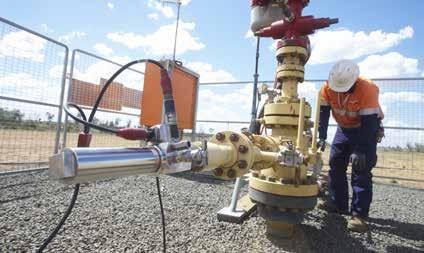
4 minute read
A Bowen-fired recovery - the future of CSG
from BBMC Yearbook 2020
by bbminingclub
David Kiefer, Media Lead, Arrow Energy
Queensland’s Bowen Basin is one of the key pillars to the Australian Government’s plans for a gas-fired national recovery from the economic impacts of the COVID-19 pandemic.
To get more gas to market, the government wants to unlock five key gas basins; the North Bowen Basin is to be one of the first three, alongside the Galilee Basin. This will fit hand-in-glove with the inaugural National Gas Infrastructure Plan that identifies priority pipelines and critical infrastructure.
The September announcements received broad support from the Australian manufacturing and resources industries. “Australia has world-class resources reserves, and developing these basins provide stable, secure and affordable energy for Australia for decades to come,” was the summation by Chief Executive Andrew McConville from the Australian Petroleum Production and Exploration Association.
Locally, Arrow Energy believes that coordinated initiatives will help the broader gas industry to unlock the gas potential of the Bowen Basin. Arrow, which has been commercially producing natural gas from the coal seams around Moranbah since 2004, welcomed the chance to work with the State and Federal governments on these initiatives. The stakes are high:
• Natural gas provides almost 24% of Australia’s primary energy
• Almost one-third of all gas consumed in Australia is used by manufacturers
• Natural gas provides more than 60% of electricity generation in Western Australia and the Northern Territory and almost 50% in South Australia
• While Australia’s oil production peaked in 2000 at 287 million barrels of oil, progressively dropping to 126 million barrels of oil in 2018, natural gas production has more than doubled over the past five years
• Globally, natural gas is the fastest-growing energy source, accounting today for 23% of global primary energy demand and nearly a quarter of electricity generation1
Balancing extraction with production costs
The current question is how to bring the Bowen Basin’s gas to a market in which world oil prices have declined and where market demand is low. The target coals in the Bowen are different to the Surat and require different drilling techniques.
The Bowen seams, while much thicker than in the Surat, are dense. As a result, vertical CSG wells (as used in the Surat Basin) do not result in economically sustainable flow rates.
For some years, Arrow has been developing and refining deviated, inseam wells – drilling a bore that angles away from the vertical it descends, until it runs horizontally along the target coal seam for a couple of kilometres. This method exposes much more of the seam than a vertical well.
Arrow has extended the basic idea to drilling multiple side-branch bores off the main bore, exposing even more of the coal. These new well types are known as “multi-laterals”. The design is evolving as techniques are proved and disproved, and lessons are learned from long-term operation.
This evolution of design is one of the strengths of CSG. Whereas traditional oil and gas operate very much in the bespoke development, one-shot, right-first-time, major-spend-up-front space, unconventional gas production does not.
Expanding coal seam gas development in the Bowen Basin requires balancing production volumes with extraction costs. Continuously lowering production costs will allow step-out in areas with lower quality coals. This also leads towards long-term business growth. Resources that are marginal or unviable today will become economically attractive in 10 or 20 years with technology and execution excellence continuously improving.
Coal Seam Gas explained
Natural gas is predominantly methane, and coal seam gas (CSG) has one of the highest proportions of methane of any natural gas. The Bowen Basin is already producing CSG for power generation and industrial use.
The Moranbah Gas Project has been producing gas since 2004. Owned 50-50 between AGL and Arrow Energy (Arrow is the upstream operator), it feeds the North Queensland Gas Pipeline that supplies large industrial customers in Townsville, including the Yabulu gas-fired power station.
CSG is a very portable energy source, transportable as gas via pipelines or, if cooled to minus 161 degrees, then as liquefied natural gas (LNG) that can be carried in ships to anywhere in the world. That’s why CSG is an important Queensland export commodity.
CSG is an industry that can co-exist with Central Queensland’s two great pillars – agriculture and coal mining. The wells go in the ground, drain the gas for 15 to 25 years and, afterwards, are plugged with cement, cut off below-ground, and normal activity resumes above. Or below.
Against global LNG competition, CSG suffers the economic disadvantage of being a relatively pure energy source - CSG wells produce no commercial liquids, like oil, unlike other LNG projects where up to 50% of the income can come from liquids produced from the gas wells. With CSG, all the revenue must come from the gas. Arrow holds 6,168km2 of tenements in the Bowen Basin for current and future, domestic and export production.










